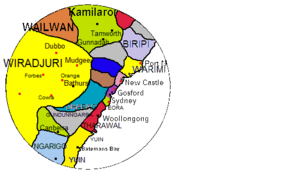Worimi language facts for kids
Quick facts for kids Worimi |
||||
|---|---|---|---|---|
| Gadhang Lower North Coast language |
||||
| Region | New South Wales | |||
| Ethnicity | Worimi, Birpai, Gringai | |||
| Extinct | (date missing) | |||
| Language family | ||||
| Dialects |
Gadjang (Kattang, Katthang, Gathang)
Worimi (Warimi)
Birbay (Birrpayi)
|
|||
| AIATSIS | E67 | |||
|
||||
The Worimi language (also called Warrimay or Gadjang) is an important Aboriginal language from Australia. It was traditionally spoken by the Worimi people. Today, most of their descendants speak English. But good news! People are working hard to bring the language back to life. They are creating a dictionary and even a special course to teach Gathang.
Contents
Understanding the Worimi Language Family
The Worimi language is part of a larger group of languages. It is most closely related to the Awabakal language. Both are in the Yuin–Kuric group. This group is a part of the even bigger Pama–Nyungan family of languages.
Some experts, like Bowern (in 2011), think that Gadjang, Worimi, and Birrpayi are actually three separate languages.
Sounds of Worimi: How it's Spoken
Learning a language means understanding its sounds. Worimi has its own special vowels and consonants.
Vowel Sounds in Worimi
Vowels are sounds like 'a', 'e', 'i', 'o', 'u'. Worimi has a few main vowel sounds.
| Front Vowels | Back Vowels | |
|---|---|---|
| High Sounds | ɪ iː i ii | ʊ uː u uu |
| Low Sounds | ə aː a aa | |
There is also a special sound called a diphthong. This is when two vowel sounds blend together. In Worimi, the diphthong "ay" sounds like [aj].
Consonant Sounds in Worimi
Consonants are sounds like 'b', 'c', 'd', 'f'. Worimi has many different consonant sounds.
| Bilabial | Velar | Dental | Palatal | Alveolar | |
|---|---|---|---|---|---|
| Voiceless Stop | p p | k k | t̪ th | c tj | t t |
| Voiced Stop | b b | g g | d̪ dh | ɟ dj | d d |
| Nasal | m m | ŋ ng | n̪ nh | ɲ ny/yn | n n |
| Lateral | l l | ||||
| Approximant | w w | j y | ɹ~ɾ r | ||
| Flap/Trill | ɾ~r rr | ||||
In the way Worimi is written, both quiet (voiceless) and loud (voiced) stop sounds are used. Words usually start with loud stop sounds. Also, only loud stop sounds can be found in groups of consonants or at the end of words.
Sometimes, the way words are written can be a bit confusing. For example, in the dictionary, it says to use quiet stop sounds in the middle of words. But this rule is not always followed, like in the word magu, which means axe.
The sounds /p/ and /b/ might be different in meaning. For example, gaparr means baby or boy, and gabarr means head. This difference is not always clear.
There is also some evidence that dental and palatal stop sounds can be mixed up. This means you might hear them used in different ways for the same word. An example is djinggarr or dhinggarr, both meaning silver or grey.
At the end of a word, a nasal sound might also be pronounced like its matching stop sound. For example, bakan or bakat both mean rock.
Sometimes, the "b" sound in the middle of a word can be pronounced like a "v" sound.
See also
 In Spanish: Idioma worimi para niños
In Spanish: Idioma worimi para niños


